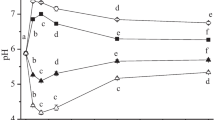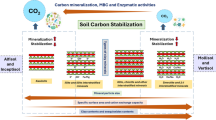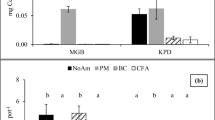Abstract
Climate change is a global challenge that is accelerated by contamination with hazardous substances like arsenic (As), posing threat to the agriculture, ecosystem and human health. Here, we explored the impact of various ameliorants on geochemical distribution of As in two soils with contrasting textures (sandy clay loam (Khudpur Village) and clay loam (Mattital Village)) under paddy soil conditions and their influence on the CO2-carbon efflux. The exchangeable As pool in clay loam soil increased as: lignite (0.4%) < biogas slurry (6%) < cow dung (9%), and < biochar (20%). However, in the sandy clay loam soil exchangeable soil As pool was found to be maximum with farmyard manure followed by biogas slurry, biochar and cow dung (17%, 14%, 13% and 7%, respectively). Interestingly, in the sandy clay loam soil the percentage As distribution in organic fraction was: biochar (38%) > cow dung (33%) > biogas slurry (23%) > sugarcane bagasse (22%) > farmyard manure (21%) that was higher compared to the clay loam soil (< 6% for all the amendments). In addition to the highest As immobilization by biochar in sandy clay loam soil, it also led to the lowest CO2-carbon efflux (1470 CO2–C mg kg−1) among all the organic/inorganic amendments. Overall, the current study advances our understanding on the pivotal role of organic amendments, notably biochar, in immobilizing As under paddy soil conditions with low (CO2) carbon loss, albeit it is dependent on soil and ameliorant types.
Graphical abstract







Similar content being viewed by others
Data availability
All extra data are available in Supplementary Information and raw data may be provided if requested by the Editor or readers of paper on request.
References
Acosta, J. A., Arocena, J. M., & Faz, A. (2015). Speciation of arsenic in bulk and rhizosphere soils from artisanal cooperative mines in Bolivia. Chemosphere, 138, 1014–1020.
Allard, B. (2006). A comparative study on the chemical composition of humic acids from forest soil, agricultural soil and lignite deposit: Bound lipid, carbohydrate and amino acid distributions. Geoderma, 130(1), 77–96. https://doi.org/10.1016/j.geoderma.2005.01.010
Bottomley, P. J., Angle, J. S., & Weaver, R. (2020). Methods of soil analysis, Part 2: Microbiological and biochemical properties (Vol. 12). John Wiley & Sons.
Bundschuh, J., Armienta, M. A., Morales-Simfors, N., Alam, M. A., López, D. L., Delgado Quezada, V., Dietrich, S., Schneider, J., Tapia, J., Sracek, O., Castillo, E., Marco Parra, L.-M., Altamirano Espinoza, M., Guimarães Guilherme, L. R., Sosa, N. N., Niazi, N. K., Tomaszewska, B., Lizama Allende, K., Bieger, K., … Ahmad, A. (2021). Arsenic in Latin America: New findings on source, mobilization and mobility in human environments in 20 countries based on decadal research 2010–2020. Critical Reviews in Environmental Science and Technology, 51(16), 1727–1865. https://doi.org/10.1080/10643389.2020.1770527
Canessa, R., van den Brink, L., Saldaña, A., Rios, R. S., Hättenschwiler, S., Mueller, C. W., Prater, I., Tielbörger, K., & Bader, M. Y. (2021). Relative effects of climate and litter traits on decomposition change with time, climate and trait variability. Journal of Ecology, 109(1), 447–458.
Cui, J.-l, Zhao, Y.-p, Li, J.-s, Beiyuan, J.-z, Tsang, D. C. W., Poon, C.-s, Chan, T.-s, Wang, W.-x, & Li, X.-d. (2018). Speciation, mobilization, and bioaccessibility of arsenic in geogenic soil profile from Hong Kong. Environmental Pollution, 232, 375–384. https://doi.org/10.1016/j.envpol.2017.09.040
Dotaniya, M., Rajendiran, S., Meena, V., Saha, J., Coumar, M. V., Kundu, S., & Patra, A. (2017). Influence of chromium contamination on carbon mineralization and enzymatic activities in Vertisol. Agricultural Research, 6(1), 91–96.
El-Naggar, A., Lee, S. S., Awad, Y. M., Yang, X., Ryu, C., Rizwan, M., Rinklebe, J., Tsang, D. C., & Ok, Y. S. (2018). Influence of soil properties and feedstocks on biochar potential for carbon mineralization and improvement of infertile soils. Geoderma, 332, 100–108.
El-Naggar, A. H., Usman, A. R., Al-Omran, A., Ok, Y. S., Ahmad, M., & Al-Wabel, M. I. (2015). Carbon mineralization and nutrient availability in calcareous sandy soils amended with woody waste biochar. Chemosphere, 138, 67–73.
Gustave, W., Yuan, Z.-F., Sekar, R., Chang, H.-C., Zhang, J., Wells, M., Ren, Y.-X., & Chen, Z. (2018). Arsenic mitigation in paddy soils by using microbial fuel cells. Environmental Pollution, 238, 647–655. https://doi.org/10.1016/j.envpol.2018.03.085
Hussain, M. M., Bibi, I., Niazi, N. K., Nawaz, M. F., & Rinklebe, J. (2021). Impact of organic and inorganic amendments on arsenic accumulation by rice genotypes under paddy soil conditions: A pilot-scale investigation to assess health risk. Journal of Hazardous Materials. https://doi.org/10.1016/j.jhazmat.2021.126620
Hussain, M. M., Bibi, I., Niazi, N. K., Shahid, M., Iqbal, J., Shakoor, M. B., Ahmad, A., Shah, N. S., Bhattacharya, P., Mao, K., Bundschuh, J., Ok, Y. S., & Zhang, H. (2021). Arsenic biogeochemical cycling in paddy soil-rice system: Interaction with various factors, amendments and mineral nutrients. Science of The Total Environment. https://doi.org/10.1016/j.scitotenv.2021.145040
Hussain, M. M., Farooqi, Z. U. R., Rasheed, F., & Din, W. M. U. (2021). Role of microorganisms as climate engineers: Mitigation and adaptations to climate change. In Javid A. Parray, Suhaib A. Bandh, & Nowsheen Shameem (Eds.), Climate change and microbes: Impacts and vulnerability. (Vol. 1). Apple Academic Press.
Hussain, M. M., Wang, J., Bibi, I., Shahid, M., Niazi, N. K., Iqbal, J., Mian, I. A., Shaheen, S. M., Bashir, S., & Shah, N. S. (2020). Arsenic speciation and biotransformation pathways in the aquatic ecosystem: The significance of algae. Journal of Hazardous Materials, 403, 124027.
Javed, M. B., Kachanoski, G., & Siddique, T. (2013). A modified sequential extraction method for arsenic fractionation in sediments. Analytica Chimica Acta, 787, 102–110.
Kurganskaya, I., Niazi, N.K., & Luttge, A. (2021). A modeling approach for unveiling adsorption of toxic ions on iron oxide nanocrystals. Journal of Hazardous Materials, 417, 126005.
Kuzyakov, Y., & Cheng, W. (2001). Photosynthesis controls of rhizosphere respiration and organic matter decomposition. Soil Biology and Biochemistry, 33(14), 1915–1925.
Lal, R. (2015). Restoring soil quality to mitigate soil degradation. Sustainability, 7(5), 5875–5895.
Laurent, C., Bravin, M. N., Crouzet, O., Pelosi, C., Tillard, E., Lecomte, P., & Lamy, I. (2020). Increased soil pH and dissolved organic matter after a decade of organic fertilizer application mitigates copper and zinc availability despite contamination. Science of the Total Environment, 709, 135927. https://doi.org/10.1016/j.scitotenv.2019.135927
Lim, S.-S., Choi, W.-J., Lee, K.-S., & Ro, H.-M. (2012). Reduction in CO 2 emission from normal and saline soils amended with coal fly ash. Journal of Soils and Sediments, 12(9), 1299–1308.
Liu, Y., Tran, T., Postma, G., Buydens, L., & Jansen, J. (2018a). Estimating the number of components and detecting outliers using angle distribution of loading subspaces (ADLS) in PCA analysis. Analytica Chimica Acta, 1020, 17–29.
Liu, Y., Zhu, X., Wei, X., Zhang, S., Chen, J., & Ren, Z. J. (2018b). CO2 activation promotes available carbonate and phosphorus of antibiotic mycelial fermentation residue-derived biochar support for increased lead immobilization. Chemical Engineering Journal, 334, 1101–1107. https://doi.org/10.1016/j.cej.2017.11.033
Lombi, E., Sletten, R., & Wenzel, W. (2000). Sequentially extracted arsenic from different size fractions of contaminated soils. Water, Air, and Soil Pollution, 124(3), 319–332.
Majumdar, A., Upadhyay, M. K., Giri, B., Srivastava, S., Srivastava, A. K., Jaiswal, M. K., & Bose, S. (2020). Arsenic dynamics and flux assessment under drying-wetting irrigation and enhanced microbial diversity in paddy soils: A four year study in Bengal delta plain. Journal of Hazardous Materials, 409, 124443.
Miller RO, Kalra Y (1998) Nitric-perchloric acid wet digestion in an open vessel. Handbook of reference methods for plant analysis:1:57–61
Mladenov, N., Zheng, Y., Miller, M. P., Nemergut, D. R., Legg, T., Simone, B., Hageman, C., Rahman, M. M., Ahmed, K. M., & McKnight, D. M. (2010). Dissolved organic matter sources and consequences for iron and arsenic mobilization in Bangladesh aquifers. Environmental Science & Technology, 44(1), 123–128.
Natasha, B. I., Shahid, M., Niazi, N. K., Younas, F., Naqvi, S. R., Shaheen, S. M., Imran, M., Wang, H., Hussaini, K. M., & Zhang, H. (2021). Hydrogeochemical and health risk evaluation of arsenic in shallow and deep aquifers along the different floodplains of Punjab, Pakistan. Journal of Hazardous Materials, 402, 124074.
Niazi, N. K., Singh, B., & Shah, P. (2011). Arsenic speciation and phytoavailability in contaminated soils using a sequential extraction procedure and XANES spectroscopy. Environmental Science & Technology, 45(17), 7135–7142.
Olsen, S. R. (1954). Estimation of available phosphorus in soils by extraction with sodium bicarbonate (Vol. 939). US Department of Agriculture.
Pehlivan, E., Tran, H., Ouédraogo, W., Schmidt, C., Zachmann, D., & Bahadir, M. (2013). Sugarcane bagasse treated with hydrous ferric oxide as a potential adsorbent for the removal of As (V) from aqueous solutions. Food Chemistry, 138(1), 133–138.
Posadas, E., Morales, Md. M., Gomez, C., Acién, F. G., & Muñoz, R. (2015). Influence of pH and CO2 source on the performance of microalgae-based secondary domestic wastewater treatment in outdoors pilot raceways. Chemical Engineering Journal, 265, 239–248. https://doi.org/10.1016/j.cej.2014.12.059
Rahman, F., Rahman, M. M., Rahman, G. M., Saleque, M., Hossain, A. S., & Miah, M. G. (2016). Effect of organic and inorganic fertilizers and rice straw on carbon sequestration and soil fertility under a rice–rice cropping pattern. Carbon Management, 7(1–2), 41–53.
Rayment, G. E., & Lyons, D. J. (2011). Soil chemical methods: Australasia (Vol. 3). CSIRO publishing.
Regmi, A. D., Yoshida, K., Dhital, M. R., & Devkota, K. (2013). Effect of rock weathering, clay mineralogy, and geological structures in the formation of large landslide, a case study from Dumre Besei landslide lesser Himalaya Nepal. Landslides, 10(1), 1–13.
Rinklebe, J., Shaheen, S. M., & Frohne, T. (2016). Amendment of biochar reduces the release of toxic elements under dynamic redox conditions in a contaminated floodplain soil. Chemosphere, 142, 41–47. https://doi.org/10.1016/j.chemosphere.2015.03.067
Ryan J, Estefan G, Rashid A (2001) Soil and plant analysis laboratory manual, International Centre for Agricultural Research in the Dry Areas (ICARDA). Aleppo and National Agricultural Research Centre (NARC), Islamabad, Pakistan
Shaheen, S. M., El-Naggar, A., Antoniadis, V., Moghanm, F. S., Zhang, Z., Tsang, D. C., Ok, Y. S., & Rinklebe, J. (2020). Release of toxic elements in fishpond sediments under dynamic redox conditions: Assessing the potential environmental risk for a safe management of fisheries systems and degraded waterlogged sediments. Journal of environmental management, 255, 109778.
Shakoor, M. B., Niazi, N. K., Bibi, I., Shahid, M., Sharif, F., Bashir, S., Shaheen, S. M., Wang, H., Tsang, D. C., & Ok, Y. S. (2018). Arsenic removal by natural and chemically modified water melon rind in aqueous solutions and groundwater. Science of the Total Environment, 645, 1444–1455.
Srithongkul, C., Wongsaipun, S., Krongchai, C., Santasup, C., & Kittiwachana, S. (2019). Investigation of mobility and bioavailability of arsenic in agricultural soil after treatment by various soil amendments using sequential extraction procedure and multivariate analysis. CATENA, 181, 104084. https://doi.org/10.1016/j.catena.2019.104084
Stefaniuk, M., & Oleszczuk, P. (2016). Addition of biochar to sewage sludge decreases freely dissolved PAHs content and toxicity of sewage sludge-amended soil. Environmental Pollution, 218, 242–251.
Stietiya, M. H., & Wang, J. J. (2011). Effect of organic matter oxidation on the fractionation of copper, zinc, lead, and arsenic in sewage sludge and amended soils. Journal of Environmental Quality, 40(4), 1162–1171.
Sun, J., He, F., Zhang, Z., Shao, H., & Xu, G. (2016). Temperature and moisture responses to carbon mineralization in the biochar-amended saline soil. Science of the Total Environment, 569, 390–394.
Tahir, M. M., Khurshid, M., Khan, M. Z., Abbasi, M. K., & Kazmi, M. H. (2011). Lignite-derived humic acid effect on growth of wheat plants in different soils. Pedosphere, 21(1), 124–131. https://doi.org/10.1016/S1002-0160(10)60087-2
Tajernia, H., Ebadi, T., Nasernejad, B., & Ghafori, M. (2014). Arsenic removal from water by sugarcane bagasse: An application of response surface methodology (RSM). Water, Air, & Soil Pollution, 225(7), 2028. https://doi.org/10.1007/s11270-014-2028-4
Vranova, V., Rejsek, K., & Formanek, P. (2013). Aliphatic, cyclic, and aromatic organic acids, vitamins, and carbohydrates in soil: A review. The Scientific World Journal, 2013, 524239. https://doi.org/10.1155/2013/524239
Walkley, A., & Black, I. A. (1934). An examination of the Degtjareff method for determining soil organic matter, and a proposed modification of the chromic acid titration method. Soil Science, 37(1), 29–38.
Wen, E., Yang, X., Chen, H., Shaheen, S. M., Sarkar, B., Xu, S., Song, H., Liang, Y., Rinklebe, J., & Hou, D. (2021). Iron-modified biochar and water management regime-induced changes in plant growth, enzyme activities, and phytoavailability of arsenic, cadmium and lead in a paddy soil. Journal of Hazardous Materials, 407, 124344.
Wu, C., Zheng, Y., Yang, H., Yang, Y., & Wu, Z. (2021). Effects of different particle sizes on the spectral prediction of soil organic matter. CATENA, 196, 104933.
XLSTAT, X. (2017). Data analysis and statistical solution for Microsoft Excel. Addinsoft Paris.
Yang, X., Hinzmann, M., Pan, H., Wang, J., Bolan, N., Tsang, D. C., Ok, Y. S., Wang, S.-L., Shaheen, S. M., & Wang, H. (2021). Pig carcass-derived biochar material cause contradictory effects on arsenic mobilization in a contaminated paddy soil under fluctuating controlled redox conditions. Journal of Hazardous Materials, 421, 126647.
Yang, X., Li, J., Liang, T., Yan, X., Zhong, L., Shao, J., El-Naggar, A., Guan, C.-Y., Liu, J., & Zhou, Y. (2021). A combined management scheme to simultaneously mitigate As and Cd concentrations in rice cultivated in contaminated paddy soil. Journal of Hazardous Materials, 416, 125837.
Zhai, W., Dai, Y., Zhao, W., Yuan, H., Qiu, D., Chen, J., Gustave, W., Maguffin, S. C., Chen, Z., Liu, X., Tang, X., & Xu, J. (2020). Simultaneous immobilization of the cadmium, lead and arsenic in paddy soils amended with titanium gypsum. Environmental Pollution, 258, 113790. https://doi.org/10.1016/j.envpol.2019.113790
Zhao, T.-T., Ge, W.-Z., Yue, F., Wang, Y.-X., Pedersen, C. M., Zeng, F.-G., & Qiao, Y. (2016). Mechanism study of Cr (III) immobilization in the process of Cr (VI) removal by Huolinhe lignite. Fuel Processing Technology, 152, 375–380.
Zheng, L., Apps, J. A., Zhang, Y., Xu, T., & Birkholzer, J. T. (2009). On mobilization of lead and arsenic in groundwater in response to CO2 leakage from deep geological storage. Chemical Geology, 268(3–4), 281–297.
Zibilske, L. (1994). Carbon mineralization. Methods of Soil Analysis: Part 2 Microbiological and Biochemical Properties, 5, 835–863.
Acknowledgements
The authors are thankful to Higher Education Commission (Project Nos. 6425/Punjab/NRPU/R&D/HEC/2016 and 6396/Punjab/NRPU/R&D/HEC/2016), Pakistan, for providing financial support. Drs Nabeel Khan Niazi and Irshad Bibi are thankful to the University of Agriculture Faisalabad. Dr Irshad Bibi acknowledges the support form COMSTEQ-TWAS research grant 2018 (18-268 RG/EAS/AS_C).
Author information
Authors and Affiliations
Contributions
MMH, NKN, IB conceptualized the idea. MMH prepared initial draft. FA helped in various statistical analysis. NKN, IB, FA, ZAS and MS read, edited and improved the paper. KH, SMS, HW, QS and JR read, edited and improved paper.
Corresponding author
Ethics declarations
Conflict of interest
The authors declare that they have no known competing financial interests or personal relationships that could have appeared to influence the work reported in this paper.
Additional information
Publisher's Note
Springer Nature remains neutral with regard to jurisdictional claims in published maps and institutional affiliations.
Supplementary Information
Below is the link to the electronic supplementary material.
Rights and permissions
About this article
Cite this article
Hussain, M.M., Bibi, I., Ali, F. et al. The role of various ameliorants on geochemical arsenic distribution and CO2-carbon efflux under paddy soil conditions. Environ Geochem Health 45, 507–523 (2023). https://doi.org/10.1007/s10653-021-01196-3
Received:
Accepted:
Published:
Issue Date:
DOI: https://doi.org/10.1007/s10653-021-01196-3




